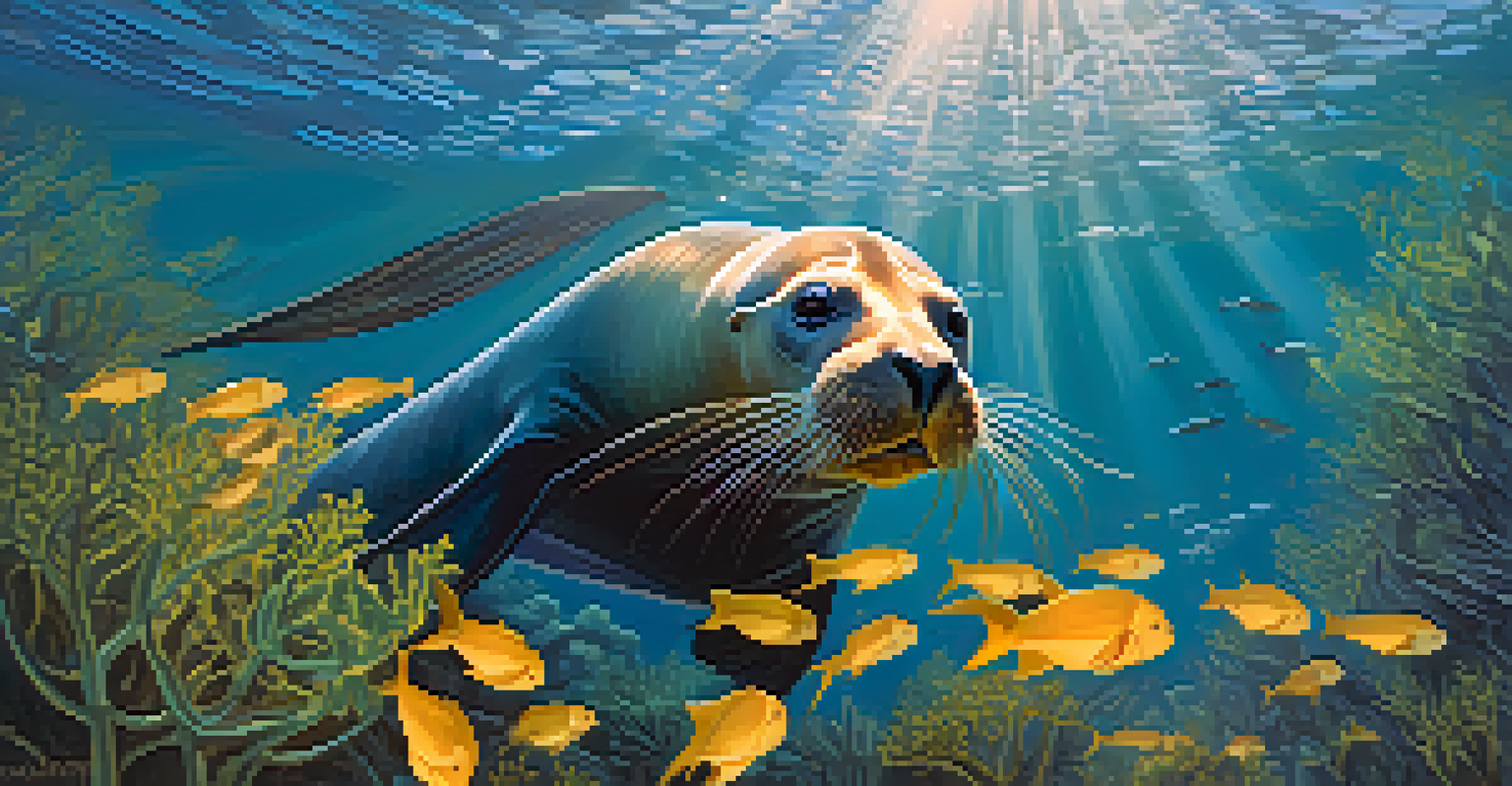Exploring the Seals of San Diego: Habitats and Behaviors

Introduction to San Diego's Seals and Their Importance
San Diego is home to a vibrant seal population, particularly the harbor seals and California sea lions. These marine mammals play a vital role in the coastal ecosystem, helping to maintain the balance of marine life. Their presence not only enriches the biodiversity of the area but also draws visitors, enhancing local tourism and education.
The sea, once it casts its spell, holds one in its net of wonder forever.
Seals are fascinating creatures, known for their playful behaviors and social structures. Observing them in their natural habitat offers a unique glimpse into their world, showcasing their interactions with one another and their environment. This article will explore the various habitats seals thrive in and their intriguing behaviors.
By understanding seals better, we can appreciate their role in marine ecosystems and the importance of conservation efforts to protect them. As we dive deeper into their habitats and behaviors, we’ll uncover the secrets of these charming animals and how they contribute to the rich tapestry of San Diego's coastal life.
Key Species of Seals Found in San Diego
In San Diego, two primary species of seals can be observed: the harbor seal and the California sea lion. Harbor seals are typically found lounging on rocky shores or sandy beaches, characterized by their spotted coats and rounded faces. In contrast, California sea lions are more social and vocal, often seen in large groups, barking loudly as they sunbathe or play.

Each species has unique characteristics and behaviors that set them apart. For example, harbor seals are generally more solitary, preferring to rest alone or in small groups. Meanwhile, California sea lions are known for their playful nature, often engaging in acrobatics and social interactions with one another.
Seals are vital to ecosystems
Harbor seals and California sea lions play crucial roles in maintaining the balance of marine life and enhancing local biodiversity.
These distinct behaviors not only make them interesting to observe but also highlight the diversity within the seal population in San Diego. Understanding these differences can enhance our appreciation for them and raise awareness about the need to protect their habitats.
Preferred Habitats of San Diego's Seals
San Diego's coastal areas provide ideal habitats for seals, featuring rocky shorelines, sandy beaches, and kelp forests. These environments offer seals safe resting spots while they bask in the sun and raise their pups. The varied terrain also provides protection from predators and harsh weather conditions.
In every drop of water, there is a story of life.
Harbor seals often prefer secluded coves and rocky outcrops, where they can haul out without disturbance. These locations are usually away from human activity, ensuring a peaceful environment for resting and nursing their young. On the other hand, California sea lions are more adaptable and can often be seen in more populated areas, such as piers and marinas.
The availability of food sources, like fish and squid, also influences their habitat choices. Coastal waters rich in marine life are crucial for seals, as they rely on these resources to thrive. This connection between habitat and food is essential for their survival and well-being.
Seasonal Behaviors of Seals in San Diego
Seals exhibit fascinating seasonal behaviors that align with breeding and pupping cycles. For instance, California sea lions typically breed between May and August, and during this time, males establish territories to attract females. This behavior often leads to increased vocalizations and displays of dominance among males.
In contrast, harbor seals have a shorter pupping season, peaking between March and June. Mothers give birth to their pups on sandy beaches or rocky shores, where they can be protected from predators. This nurturing phase is crucial as mothers must frequently return to the ocean to hunt for food while leaving their pups safely nestled onshore.
Distinct behaviors of seal species
Harbor seals are more solitary, while California sea lions are social and vocal, highlighting the diversity within San Diego's seal population.
These seasonal behaviors remind us of the delicate balance in nature, where the timing of breeding and pup-rearing is essential for the survival of seal populations. Observing these cycles can deepen our understanding of their life stages and the environmental factors that influence them.
Social Structures and Interactions Among Seals
Seals are social animals, and their interactions within groups can reveal much about their behaviors. California sea lions, for instance, thrive in large colonies, where they engage in playful activities and social grooming. This bonding helps strengthen relationships and establish social hierarchies within the group.
In contrast, harbor seals tend to be more solitary or live in smaller groups. They often prefer to maintain personal space, which can be observed when they haul out on rocks or beaches. However, even in these smaller gatherings, they communicate with one another through body language and vocalizations.
Understanding these social structures is crucial for conservation efforts, as it highlights the importance of protecting their habitats. Disturbances from human activity can disrupt their social interactions, ultimately impacting their overall health and survival.
Conservation Efforts for Seals in San Diego
Conservation of seal populations in San Diego is vital to ensure their continued survival. Organizations and local agencies actively monitor seal populations, educate the public on their importance, and advocate for protected areas. These efforts are essential in promoting awareness about the challenges seals face, such as habitat loss and pollution.
One significant initiative involves designating marine protected areas (MPAs) along the California coast, where human activity is limited to safeguard critical habitats. These MPAs not only benefit seals but also promote the health of the entire marine ecosystem. Additionally, community engagement through beach clean-ups and educational programs fosters a sense of responsibility among residents and visitors.
Conservation efforts are essential
Protecting seal habitats through initiatives like marine protected areas is crucial for their survival and the health of marine ecosystems.
By participating in these conservation efforts, individuals can make a difference in the lives of seals and the health of marine environments. Every small action contributes to the larger goal of protecting these magnificent creatures and their habitats for future generations.
How to Safely Observe Seals in San Diego
If you're eager to observe seals in their natural habitat, it's essential to do so safely and responsibly. Always maintain a respectful distance to avoid disturbing them, as getting too close can cause stress and even lead to abandonment of pups. The recommended distance is at least 50 yards, allowing for a clear view without intruding on their space.
Many popular viewing spots in San Diego, such as La Jolla Cove and Point Loma, offer excellent opportunities to see seals without compromising their well-being. Consider using binoculars or a camera with a zoom lens to capture the beauty of these animals from afar. This way, you can enjoy their antics while ensuring they remain undisturbed.

Participating in guided tours can also enhance your experience, as knowledgeable guides can provide insights into seal behavior and the local ecosystem. By following these guidelines, you can enjoy the wonder of seals while promoting their conservation and welfare.